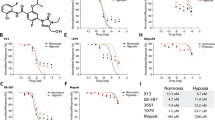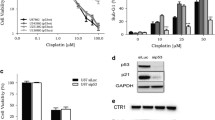Summary
4-Methyl-2,7-diamino-5,10-diphenyl-4,9-diaz-apyrenium chloride (MDDD), a stable and water soluble nucleic acid-intercalating agent, was shown to be toxic to cancer cells with IC50 around 10 μM. IC50 We tested MDDD for its potential antitumor activities and found it inhibited cancer cell growth with IC50 in the micromolar range for the majority of cancer cells tested, with the exception of glioma cells, for which the IC50 is in the submicromolar range. This unique selectivity of MDDD to glioma cells can potentially be exploited for anti-glioma therapeutics. Although the underlying mechanisms for the apparent glioma specificity remain to be elucidated, our analysis indicates that MDDD significantly reduces cell clonogenicity and blockes cell proliferation at the G1 phase. MDDD treatment also triggers induction of p53 and p21 at the protein levels, suggesting the activation of DNA damage response. However, MDDD mediated growth inhibition does not require the p53 pathway since p53+/− isogenic cell pairs display the same sensitivity. These properties of MDDD favor its candidacy for evaluation as a new anti-tumor agent, particularly for glioma.
Similar content being viewed by others
References
Greenlee RT, Murray T, Bolden S,Wingo PA (2000) Cancer statistics, 2000. CA Cancer J Clin 50:7–33
CBTRUS Central Brain Tumor Registry of the United States, Primary Brain Tumors in the United States Statistical Report 1995–1999 edition, pp. 2002
Pendergrass TW, Milstein JM, Geyer JR, Mulne AF, Kosnik EJ, Morris JD, Heideman RL, Ruymann FB, Stuntz JT, Bleyer WA (1987) Eight drugs in one day chemotherapy for brain tumors: Experience in 107 children and rationale for preradiation chemotherapy. J Clin Oncol 5:1221–1231
Parney IF, Chang SM (2003) Current chemotherapy for glioblastoma. Cancer J 9:149–156
Hirose Y, Berger MS, Pieper RO (2001) p53 effects both the duration of G2/M arrest and the fate of temozolomide-treated human glioblastoma cells. Cancer Res 61:1957–1963
Piantanida I, Palm BS, Zinic M, Schneider H-J (2001) A new 4,9-diazapyrenium intercalator for single- and double-stranded nuclei acids: distinct differences from related diazapyrenium compounds and ethidium bromide. J Chem Soc Perkin Trans 2:1808–1816
Steiner-Biocic I, Glavas-Obrovac L, Karner I, Piantanida I, Zinic M, Pavelic K, Pavelic J (1996) 4,9-diazapyrenium dications induce apoptosis in human tumor cells. Anticancer Res 16:3705–3708
Ronic S, Glavas-Obrovac L, Karner I, Piantanida I, Zinic M, Pavelic K (2000) In vitro Cytotoxicity of three 4,9-diazapyrenium hydrogensulfate derivatives on different human tumor cell lines. Chemotherapy 46:143–149
Claassen G, Ke N, Yu DH, Chatterton JE, Hu X, Albers A, Nguy V, Chionis J, Truong T, Meyhack B, Wong-Staal F, Li QX (2004) Comprehensive assessment of cell growth properties affected by various agents using an integrated and non-subjective approach. Preclinica 2:435–439
Brummelkamp TR, Bernards R, Agami R (2002) Stable suppression of tumorigenicity by virus-mediated RNA interference. Cancer Cell 2:243–247
Tiscornia G, Singer O, Ikawa M, Verma IM (2003) A general method for gene knockdown in mice by using lentiviral vectors expressing small interfering RNA. Proc Natl Acad Sci USA 100:1844–1848
Ke N, Albers A, Claassen G, Yu DH, Chatterton JE, Hu X, Meyhack B, Wong-Staal F, Li QX (2004) One-week 96-well soft agar growth assay for cancer target validation. Biotechniques 36:826–828, 830, 832–823
Ke N, Claassen G, Yu DH, Albers A, Fan W, Tan P, Grifman M, Hu X, Defife K, Nguy V, Meyhack B, Brachat A, Wong-Staal F, Li QX (2004) Nuclear hormone receptor NR4A2 is involved in cell transformation and apoptosis. Cancer Res 64:8208–8212
Fiebig HH, Maier A, Burger AM (2004) Clonogenic assay with established human tumour xenografts: correlation of in vitro to in vivo activity as a basis for anticancer drug discovery. Eur J Cancer 40:802–820
Weiss RH (2003) p21Waf1/Cip1 as a therapeutic target in breast and other cancers. Cancer Cell 4:425–429
Yu DH, Chatterton JE, Ke N, Nguy V, Bliesath JR, Hu X, Meyhack B, Wong-Staal F, Li QX (2005) A 96 well surrogate survival assay coupled with a special RNAi vector strategy for cancer gene target identification and validation with enhanced signal/noise ratio. Assay Drug Dev Tech 3:401–411
Valtonen S, Timonen U, Toivanen P, Kalimo H, Kivipelto L, Heiskanen O, Unsgaard G, Kuurne T (1997) Interstitial chemothrepy with carmustine-loaded polymers for high-grade gliomas: A randomized double-blinds. Neurosurgery 41:44–49
Chen Y, Sanchez Y (2004) Chk1 in the DNA damage response: conserved roles from yeasts to mammals. DNA Repair (Amst) 3:1025–1032
Kong XB, Rubin L, Chen LI, Ciszewska G, Watanabe KA, Tong WP, Sirotnak FM, Chou TC (1992) Topoisomerase II-mediated DNA cleavage activity and irreversibility of cleavable complex formation induced by DNA intercalator with alkylating capability. Mol Pharmacol 41:237–244
Author information
Authors and Affiliations
Corresponding author
Rights and permissions
About this article
Cite this article
Yu, DH., MacDonald, J., Josephs, S. et al. MDDD, a 4,9-diazapyrenium derivative, is selectively toxic to glioma cells by inducing growth arrest at G0/G1 independently of p53. Invest New Drugs 24, 489–498 (2006). https://doi.org/10.1007/s10637-006-7590-1
Published:
Issue Date:
DOI: https://doi.org/10.1007/s10637-006-7590-1




